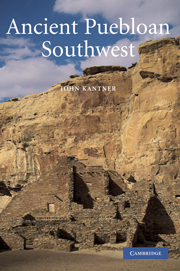Book contents
- Frontmatter
- Contents
- List of figures
- List of boxes
- Acknowledgments
- 1 The ancient Puebloan Southwest: an introduction
- 2 “The Daylight World”: the paleoenvironmental context for Puebloan history
- 3 Return to Ánosin Téhuli? The origins of Puebloan culture
- 4 The wrong Middle Places? Chaco Canyon and the Mimbres Mogollon
- 5 The migrations continue: the end of Chaco and Mimbres
- 6 The AD 1200s: the Great Pueblo period
- 7 The Great Abandonment
- 8 Finding Posi: the protohistoric Puebloan world
- References
- Index
4 - The wrong Middle Places? Chaco Canyon and the Mimbres Mogollon
Published online by Cambridge University Press: 05 February 2015
- Frontmatter
- Contents
- List of figures
- List of boxes
- Acknowledgments
- 1 The ancient Puebloan Southwest: an introduction
- 2 “The Daylight World”: the paleoenvironmental context for Puebloan history
- 3 Return to Ánosin Téhuli? The origins of Puebloan culture
- 4 The wrong Middle Places? Chaco Canyon and the Mimbres Mogollon
- 5 The migrations continue: the end of Chaco and Mimbres
- 6 The AD 1200s: the Great Pueblo period
- 7 The Great Abandonment
- 8 Finding Posi: the protohistoric Puebloan world
- References
- Index
Summary
The Hopi speak of Palatkwapi, while the Zuni relate the tale of Hán'hlipínk'ya and the Acoma talk of “White House.” Each describes a place in their ancestors' journeys where people strayed from the proper way of living. At Palatkwapi, things were good – the rains fell, the river was always full, and there was plenty of game to hunt. The older people knew that the Hopi had to continue their journey to the “Middle Place,” where they would meet up with other wandering clans. But Palatkwapi grew, people rejected the proper way of living, and evil and corruption emerged. Instead of gathering in the kivas, people gambled, harassed the elders, and neglected their ritual obligations. Only complete destruction of the village – a massive flood or choking fumes, depending on the story – reminded people of the journey they were obligated to continue (Courlander 1971; Cushing 1896; Parsons 1939).
Do the Pueblo histories refer to real places, sites that we can visit today? On one hand, the stories are parables that teach people the consequences of unethical behavior, and whether they are real places is not important. But archaeologists have identified a time in Puebloan history when selfish behavior may have troubled society – a time of plenty, but also a time of inequities, with a few people exerting more control over others and the fruits of their labor.
- Type
- Chapter
- Information
- Ancient Puebloan Southwest , pp. 87 - 125Publisher: Cambridge University PressPrint publication year: 2004



